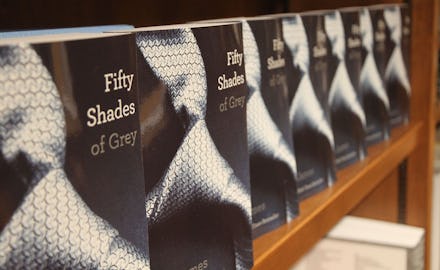The 13 Most Ridiculous, Insipid, No-Good, Terrible Passages from 'Fifty Shades of Grey'

If we never read another sentence describing the unleashing of an "inner goddess," it will be too soon.
One week before boyfriends across the country are dragged to screenings of Fifty Shades of Grey, the "erotic romantic drama" based on the eponymous best-selling book, we decided to subject ourselves to the original source material. Much scotch was needed.
We're not the first readers to venture into E.L. James' dark world of BDSM, slave-play and crimes against metaphor. Fifty Shades of Grey (along with the second and third installments in the trilogy, Fifty Shades Darker and Fifty Shades Freed) has sold more than 100 million copies worldwide, setting a record in the U.K. as the fastest-selling paperback of all time (sorry, Harry Potter).
A quick rundown of the series: The book was originally written as Twilight fan fiction, with the original series, Master of the Universe, published episodically under the nom de plume Snowqueen's Icedragon.
According to James' agent, "[She] decided to take it down after there were some comments about the racy nature of the material. She took it down and thought, I'd always wanted to write. I've got a couple unpublished novels here. I will rewrite this thing, and create these iconic characters, Christian and Ana."
The novel — it kills us to call it that, but until we publish a book that sells 100 million copies, we're in no position to be snotty — resets the cross-species romance of vampire Edward and whiny Mary Sue archetype Bella in modern-day Vancouver, Washington. Bella, now named Ana, is a virginal college senior on assignment to interview Christian Grey, a mysterious 27-year-old billionaire. The specifics of what follows don't matter, really: Girl seems awkward, boy is aggressively attracted to her despite her lack of a personality, girl runs into boy at a local hardware store buying tools to use on his lovers, boy tries to get girl to sign a sex contract (but just makes out with her in an elevator), boy welcomes girl to his "Red Room of Pain," etc.
Plug in Beyoncé's "Crazy in Love" remix and let the (obviously, insanely NFSW) writing speak for itself. Don't say we didn't warn you.
Page 25: "Or something."
Page 26: Let no one accuse E.L. James of skipping her neuro class.
Page 50: Ana is a Little Red Book of embarrassment.
Page 52: Ana gets ready for her close-up.
Page 75: Christian is a snake; desire is a smoldering, combustible stomach liquid.
Page 103: Again with the mixed stomach metaphors.
Page 116: The "inner goddess" is inconsolable.
Page 116: Ana reacts to an erection by exclaiming: "Holy cow!"
Page 137: Fellatio reminds Ana of the freezer aisle.
Page 188: Ana reveals that she minored in the classics.
Page 198: The word "behind" is used, and the virtues of baby oil are expounded upon.
Page 5,734,437: Christian just wants to be loved!
Page lemniscate: The inner goddess has switched dance classes.
The writing is infamously terrible. Upon reading it, Salman Rushdie declared that he had "never read anything so badly written that got published. It made Twilight look like War and Peace." In the New York Times, Maureen Dowd described the book as being written "like a Brontë devoid of talent," (a feat, considering that the only decent Brontë was brother Branwell, who avoided publishing any rubbish novels in favor of drinking himself to death). When Publishers Weekly named E.L. James the "Publishing Person of the Year," the New York Daily News headline blared, "Civilization Ends: E.L. James named Publishers Weekly's 'Person of the Year.'"
So what's the attraction to Fifty Shades? It's at once obvious and completely mystifying. Readers have been attracted to depictions of outré sexual proclivities in literature for at least hundreds of years: Donatien Alphonse François (better known as the Marquis de Sade and inspiration for the term "sadism") made the concept of libertinage, a philosophy predicated on the stringent disregard of authority and convention, the polestar of his writings in the 18th century. Venus in Furs, published in 1870 by Leopold von Sacher-Masoch, was revolutionary in its depiction of a woman as the dominant figure in a BDSM relationship. More recently, A Sentimental Novel by Alain Robbe-Grillet was simultaneously lauded as brilliantly written and nightmarishly troubling to read due to its sexual depictions of sadism and torture.
But none of these writings, all superior in quality, have sold hundreds of millions of copies to housewives and college students and journalists across the world.
While we'll withhold final judgment of James' oeuvre until we attend a screening of the film based on her work, we do plan on following our in-depth reading of Fifty Shades with a long shower and some Annie Proulx. Or maybe Fifty Shades Darker.
Our inner goddess is hopscotching with anticipation.